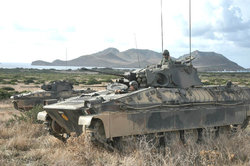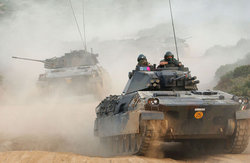Difference between revisions of "Dardo IFV"
m |
m |
||
| (2 intermediate revisions by the same user not shown) | |||
| Line 1: | Line 1: | ||
| − | {{Infobox | + | {{X}} |
| − | | | + | {| border=1 cellspacing=3 cellpadding=4 style="float:right; margin:0 0 .5em 1em; width:250px; background:#505050; border-collapse:collapse; border:1px solid #999; font-size:83%; line-height:1.5; " summary="Infobox Automobile" |
| − | | | + | |- style="text-align:center; background:#505050;" |
| − | | | + | | colspan=2 style="padding:0; background:#333333; color:#fff; border-bottom:1px solid #999;" |[[Image:Dardo 1.jpg|250px]] |
| − | | | + | |- style="color:#fff; background:darkred; font-size:larger;" |
| − | | | + | ! colspan=2 |'''Dardo''' IFV |
| − | | | + | |- |
| − | | | + | |Origin || {{flagiconITA}} [[Italy]] |
| − | | | + | |- |
| − | |wars | + | |Type || [[Infantry fighting vehicle]] |
| − | | length | + | |- |
| − | | width | + | |IS vehicle || yes |
| − | | height | + | |- |
| − | | weight | + | |design date || 1998 |
| − | | suspension | + | |- |
| − | | speed | + | |production date || 1998 |
| − | | | + | |- |
| − | | | + | |wars || [[Operation Iraqi Freedom]], War in Afghanistan |
| − | | | + | |- |
| − | | armour | + | | length || 6.7 m |
| − | | engine | + | |- |
| − | | crew | + | | width || 3.0 m |
| − | | | + | |- |
| − | | | + | | height || 2.64 m |
| − | + | |- | |
| − | + | | weight || 23.4 t | |
| + | |- | ||
| + | | suspension || [[hydropneumatic]] torsion bar | ||
| + | |- | ||
| + | | speed || 70 km/h | ||
| + | |- | ||
| + | | vehicle range || 600 km | ||
| + | |- | ||
| + | | primary armament || [[25 mm caliber|25mm]] [[Oerlikon]] KBA [[automatic cannon]]; 2x TOW Anti-Tank Missile launchers (optional) | ||
| + | |- | ||
| + | | secondary armament || 7.62 mm [[coaxial]] [[machine gun]]; Smoke-grenade launchers | ||
| + | |- | ||
| + | | armour || modular Front armour against 25mm APDS | ||
| + | |- | ||
| + | | engine || [[Iveco]] – [[Fiat]] 6V MTCA turbodiesel | ||
| + | |- | ||
| + | | crew || 3 (commander, gunner, driver) + 6 troops | ||
| + | |- | ||
| + | | engine power || 512 hp (382.2 kW) | ||
| + | |- | ||
| + | | pw ratio || 24.5 hp/tonne | ||
| + | |} | ||
| + | |||
Latest revision as of 21:43, 8 March 2009

| |
| Dardo IFV | |
|---|---|
| Origin | |
| Type | Infantry fighting vehicle |
| IS vehicle | yes |
| design date | 1998 |
| production date | 1998 |
| wars | Operation Iraqi Freedom, War in Afghanistan |
| length | 6.7 m |
| width | 3.0 m |
| height | 2.64 m |
| weight | 23.4 t |
| suspension | hydropneumatic torsion bar |
| speed | 70 km/h |
| vehicle range | 600 km |
| primary armament | 25mm Oerlikon KBA automatic cannon; 2x TOW Anti-Tank Missile launchers (optional) |
| secondary armament | 7.62 mm coaxial machine gun; Smoke-grenade launchers |
| armour | modular Front armour against 25mm APDS |
| engine | Iveco – Fiat 6V MTCA turbodiesel |
| crew | 3 (commander, gunner, driver) + 6 troops |
| engine power | 512 hp (382.2 kW) |
| pw ratio | 24.5 hp/tonne |
The Dardo is a Infantry Fighting Vehicle designed for the Italian Army as a replacement for the M113 APC. It is designed and built by the Iveco Fiat Oto Melara Syndicated Company based in Rome. Iveco is responsible for the hull and propulsion systems while Oto Melara is responsible for the weapons system and fire control system.
Description
Armament
The Dardo is primarily armed with the 25mm Oerlikon KBA automatic cannon firing 600 rounds per minute, with 200 rounds of ammunition stored in the turret ready to fire. Two 7.62mm NATO machine guns are also installed in the turret, one mounted coaxial with the main gun. Five rifle ports, two on each side on the hull and one in the rear are provided to allow troops inside to use their personal weapons if needed.
Fire control is provided by the Galileo Avionica Hitfist integrated fire control system which is capable of measuring target speed and range. The commander is provided with six episcope sights which provides 360° field of vision. The cupola can be further fitted with a panoramic stabilised sight. Additionally, a laser range finder and a thermal imager is provided for the gunner. The commander is equipped with a monitor that displays the view from the gunner night vision system.
For dealing with heavy armoured threats, two Spike-LR anti tank missiles can be installed on both sides of the turret with a maximum range of 4km.
Self protection
The Dardo hull is built from welded aluminum alloy with add on steel armour plates for increased protection. Four 80mm smoke grenade launchers, are installed on both sides of the turret, for a total of eight. Over the frontal arc the vehicle is protected against 25mm APDS projectiles. The side armour protects against 14.5 API projectiles.
Propulsion
The Dardo is powered by an Iveco 6V turbo-charge after-cooled diesel engine delivering 512 hp (382.2 kW). This drives a ZF-designed automatic transmission system which is manufactured under license by Iveco Fiat. The transmission system has four forward and two reverse gears, and incorporates the steering system and the hydraulic retarder.
The running gear consists six dual rubber lined road wheels, with three return rollers on each side and connector type tracks. The suspension consists of a torsion bar, bumper and a hydraulic shock absorber on each suspension arm. Disc brakes on each of the final drives controlled by a transmission retarder provide the braking.
Together, this allows the Dardo to achieve speeds in excess of 70 km/h, maneuver on gradients of more than 60% and ford waters up to a depth of 1.5 m.
Future variants
The Dardos currently in service with the Italian Army are fitted with the "Hitfist" IFV turret. The chassis is intended to be the basic model of a family of vehicles, which may include a 120 mm mortar carrier, command (C3I) vehicle, ambulance and light tank with a 105mm gun turret.
Combat history
Dardos were deployed with the Italian Army as part of the Italian contribution to Operation Iraqi Freedom in 2004. Currently 10 are being shipped to Afghanistan, to reinforce the Italian Battlegroups there. Also some are in use with the Italian UNIFIL contingent.
